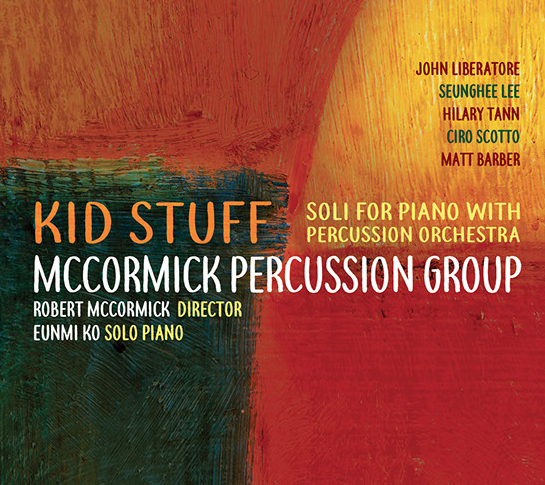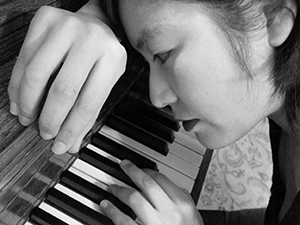McCormick Percussion Group; Robert McCormick, Director; Eunmi Ko, piano;
Music of John Liberatore, Seunghee Lee, Hilary Tann, Ciro Scotto, and Matt Barber
Ravello Records, LLC, an imprint of Parma Recordings LLC, 2018
RR7997
Recorded at the Springs Theatre in Tampa, Florida
Recording Engineer, John Stephan; Executive Producer, Bob Lord
“Kid Stuff” is an intriguing new percussion ensemble CD just released on the Ravello Records label and featuring performances by the McCormick Percussion Group under Robert McCormick with pianist Eunmi Ko. The disc is named after the longest work on it, Kid Stuff (composed 2015-17, subtitled Five Figments for Piano and Percussion) by composer Matt Barber (b. 1980), but the CD also contains four substantial compositions by composers John Liberatore, Seunghee Lee, Hilary Tann, and Ciro Scotto.
Though the subtitle of this disc, Soli for Piano with Percussion Orchestra, may set the listener up for something along the lines of the most notable piano-percussion compositions, such as Bartók’s Concerto for Two Pianos and Percussion, this disc favors much more heavily the ensemble instruments, often treating the piano as simply part of the group or even submerging its sounds amid the percussive textures of the marimba, xylophone, and other instruments.
Such an aesthetic is understandable in this case, as the McCormick Percussion Group is, on its own, a virtuoso ensemble with superb synchronization and the ability to realize highly complex scores. That said, piano soloists spend much of their lives striving for long legato lines or at least the illusion of such, and – without engaging in that age-old debate about whether piano should be categorized as a percussion instrument – movements where such piano lines came to the fore emerged as high points for this reviewer.
This Light That Pours from the four movements, This Living Air (2015), by John Liberatore was one such high point. It is a movement inspired by the poem of the same name by Garrett Brown (as are the other three movements, For Scraps of Manna, Mandrake, and It is not the Mold), and through Liberatore’s sensitive writing, the poem’s subject comes to life. From the movement’s quiet opening, pianist Eunmi Ko establishes a contemplative mood and luminous tone, gaining color and resonance through the percussion ensemble’s delicate shadings. It is a hauntingly beautiful performance. The remaining three movements of the Liberatore set are engaging in their own way – brimming with infectious patterns and brilliantly rhythmic writing – though pride of place still goes to The Light That Pours.
Considering this reviewer’s piano predilections, it may not be surprising that another highlight of this disc is a movement that borrows heavily from the Berceuse in D-flat major, Op. 57 of Frédéric Chopin, the fourth piece of Matt Barber’s Kid Stuff, entitled Cuddleys. Inspired by the composer’s infant twin daughters and a quotation from James Joyce’s Finnegan’s Wake (“what chance cuddleys…”), it is an ingenious melding of some of Chopin’s lullaby (now in G major) with the “thousands of new stimuli” that confront a vulnerable infant, all represented in the artfully “random” percussion accompanying the rocking piano part. Here is another “keeper” for this reviewer. Surrounding this movement are the playful and fantasy-filled explorations of Chimera, Night Owl, Quench, and, perhaps the most playful of all, Goofball. Each one, in its own way, reflects a fertile compositional imagination, and each is dazzlingly performed by pianist and ensemble alike.
The balance of the CD is made up of three quite different works, Pung-Kyung (2016) by Seunghee Lee, Solstice (2013) by Hilary Tann, and Dark Paradise (2016) by Ciro Scotto. Each maximized the performers’ special qualities in different ways.
Pung-Kyung, a word which the composer tells us has two meanings – both scenery and wind chime – is an apt title for this exploration of percussive tone painting. As Ms. Lee states, she uses some “repetitive yet unpredictable patterns of Korean traditional music” in evoking the mysterious lushness of an imagined Korean countryside. Timbral “images” suggest intermittent rains, rivers, sudden movements, and other fluctuations one recognizes in all nature but with a particularly exotic atmosphere here. It was good to hear such an idiomatic piano part, surely reflective of the composer’s background as pianist. One can imagine this piece finding itself welcome on many programs.
Dark Paradise, one of the lengthier works on the CD (at 13:06), is perhaps best described by its composer, Ciro Scotto, who writes that it “evokes a trip to an alien world that is simultaneously enticing but fills one with anxiety, stable and unstable, familiar and unfamiliar, and perhaps darker than earth.” Running the gamut of percussive techniques and instruments, with the pianist Eunmi Ko playing claves and crotales as well as the piano, the piece creates quite a sonic journey!
Solstice, by Welsh-born Hilary Tann, is the one duo on the CD, a pairing of pianist Eunmi Ko with marimbist Michael Skillern. An involved and imaginative work based on the writing of Adirondack woodswoman, Anne LaBastille, it is divided into the sections White Pines, Lilypad Lake, and Kestrel, bookended by preludes to spring and winter. Piano and marimba are perfectly paired here in the evocation of icy and woodsy tones, full of timbral variety and yet remarkably unified by these two fine players.
All in all, this CD makes a fascinating collection. For its important new contributions to the percussion repertoire and the sheer expertise in performance, it seems destined to become a staple in the libraries of percussion aficionados at the very least. A number of the works here may also reach a much wider audience as well.


